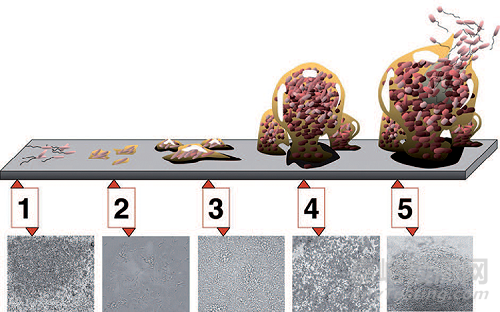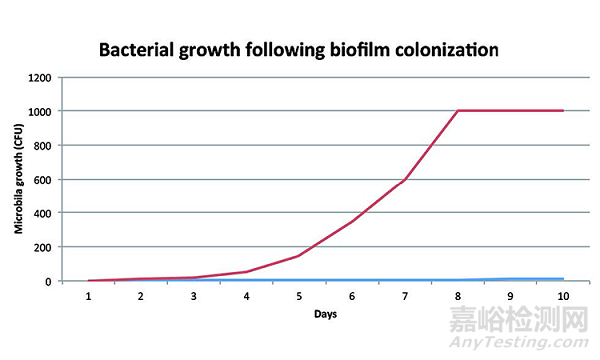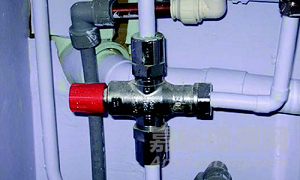您当前的位置:检测资讯 > 科研开发
嘉峪检测网 2021-08-09 21:05
MICROBIOLOGICAL CONCERNS 微生物问题
Potable water from private water companies ormunicipalities is monitored to ensure that levels of chemical pollutants remainwithin established safety criteria, and screened for microorganisms includingEscherichia coli, enterococci,Pseudomonas aeruginosa, and fecal coliforms.4In most locales the quality of the water supplied to thepharmaceutical facility is satisfactory. As a safeguard, however, manyfacilities elect to test the water for organisms like E. coli as a marker forfecal contamination. Onsite potable water is treated, softened, purified(according to the grade required), and distributed.
对私营水务公司或市政当局的饮用水进行监测,以确保化学污染物水平保持在既定的安全标准范围内,并筛查微生物,包括大肠杆菌、肠球菌、铜绿假单胞菌和粪便大肠菌群。在大多数地区,提供给制药工厂的水质都还是合格的。然而,作为一项保护措施,许多设施选择检测大肠杆菌等生物体,作为粪便污染的标志。现场饮用水经过处理、软化、纯化(根据要求等级)和分配。
While most well-designed water systems can be maintainedin a state of control, microbiological problems can develop. Microbialadherence is a consequence of the balance of attractive and repulsivephysicochemical interactions between bacteria the surface. The primary issue isbiofilm formation—slime-like microbiologicalcommunities that occur when microorganisms adhere to a surface (such aspipework with a poor flow rate).
虽然大多数设计良好的水系统可以保持在控制状态,但微生物问题可能会发生。微生物附着是细菌表面吸附性和排斥性物理化学相互作用平衡的结果。主要问题是生物膜的形成——当微生物粘附在表面时(如流速差的管道),就会发生粘液样的微生物群落。
A biofilm develops because bacterial cells, onceattached, secrete a polysaccharide known as glycocalyx (hydrated polymericslimy matrices). The glycocalyx enables each bacterium to encapsulate itself onthe surface; biofilm forms as these organisms accumulate. The steps involved inbiofilm formation are (Figure 1):
生物膜的形成是因为细菌细胞,一旦附着,会分泌一种称为糖被膜的多糖(水合聚合物粘稠基质)。糖被膜将每个细菌能够包裹;随着这些生物累计,形成生物膜。生物膜形成所涉及的步骤是(图1):
1. Individual cells populate thesurface (initial attachment)单个细胞在表面附着(初始附着)
2. Irreversible attachment不可脱落的粘附
3. Extrapolymeric substances areproduced and attachment becomes产生聚合物外物质
4. Irreversible不可逆转
5. Biofilm architecture develops andmatures生物膜结构形成并成熟
6. Single cells (or clumps of cells)are released from the biofilm over time单个菌(或菌团)随着时间的推移从生物膜中释放出来
* Adenosine triphosphate (ATP) is a nucleotide found inall living organisms; ATP bioluminescence is used to monitor contamination.
•三磷酸腺苷(ATP)是所有生物体内的一种核苷酸;ATP 荧光检测可用于监测污染。
Figure 1: Generalized biofilm formation
图1:生物膜形成

Source: D. Davis (CC BY 2.5 [http://creativecommons.org/licenses/by/2.5]), via Wikimedia Commons -footer
This type of attachment occurs relatively slowly. Variousfactors affect the process, including the type of bacterium involved, the sizeof the bacterial population in the environment, and the duration of its growthphase.5 In general, Gram-negative bacteria form biofilmsmore readily,6 due in part to appendages on the bacterial cell(fimbriae) that allow such them to attach to surfaces more easily. Surfacecharge is another important phenomenon in relation to bacterial adherence.7
这种类型的附着发生得相对较慢。影响这一过程的各种因素,包括所涉及的细菌类型、环境中细菌数量及其生长阶段的持续时间。表面电荷是细菌粘附性的另一个重要现象。
Microbial growth in a biofilm is often rapid at the pointof source (Figure 2). The pattern from user outlines is often sporadic,however, because contamination is eluted from the biofilm at different ratesover time.
生物膜中的微生物生长在源头处通常是很快的(图2)。然而,用户大体上的样本通常是零星的,因为随着时间的推移,生物膜的污染以不同的速率脱落。
Figure 2: Microbial numbers in a water system riseexponentially following biofilm formation
图2:水系统中的微生物数量在生物膜形成后呈指数级增长

Biofilms are of particular concern with water systems,since Gram-negative bacteria constitute the majority of the bacterialpopulations found in aquatic environments. These types of organisms, moreover,also shed endotoxins, a component of the cell wall.8
水系统特别关注生物膜,因为革兰氏阴性菌占水生环境中细菌群的大多数。此外,这些类型的生物也会释放内毒素——其细胞壁的组成部分。
Many stages of the water-purification process can createconditions which, although designed to reduce contaminants, paradoxicallypromote biofilm formation. An example is in-depth filtration through a matrix.As water percolates through the filter, microorganisms are adsorbed onto thematrix, where they form complex communities. Further on, the purificationpathway can create a series of colonizable environmental niches of varyingnutrient richness.
制水过程的许多阶段,虽然设计目的为减少污染,但矛盾地为生物膜的形成创造了条件。一个例子是,通过基质进行深过滤。当水通过过滤器渗透时,微生物被吸附在基质上,形成复杂的群落。此外,纯化路径也会创造一系列不同营养丰富的繁殖环境。
For appropriately designed and maintained systems,purified water and WFI present low risks of microbial contamination. Whenevermicroorganisms are detected (and certainly when above specification), however,this creates a significant hazard.
对于设计和维护适当的系统,纯化水和WFI具有低微生物污染风险。然而,每当检测到微生物(超过标准时),就会产生重大危害。
GOOD DESIGN PRINCIPLES 良好设计原则
While different phases of water generation can contributeto risks, there are a number of design and control steps that can reducemicrobiological proliferation:10
虽然制水的不同阶段都可以造成风险,但有许多设计和控制步骤可以减少微生物的繁殖:10
Break tanks 阻隔罐
Break tanks, which prevent water produced duringproduction from reentering the water supply, are the first areas in whichmicrobial colonization can occur. Microorganisms present in incoming potablewater attach themselves to the sides and bottom of the tank, forming a biofilm.Samples taken from the tank usually meet the specification for potable waterand give no immediate indication of the biomass that is accumulating. Regularmaintenance and tank flushing are the main preventive measures.
阻隔罐是微生物繁殖的最初可能发生的地方,它阻止生产期间产生的水重新进入供水系统。流入的饮用水中的微生物附着在水罐的侧面和底部,形成生物膜。从罐中采集的样品通常符合饮用水的标准,并且不会立即反映正在积累的生物量。主要预防措施是定期维护和冲洗。
Activated carbon beds 活性炭吸附床
The bed matrix consists of finely dividedcharcoal, which is highly efficient at removing low-molecular-weightorganic materials. It also oxidizes and removes additives such as chlorine. Thevast surface area and accumulation of nutrients on the bed, combined withchlorine removal, can lead to rapid microorganism colonization andproliferation. Most of the organisms are Gram-negative bacteria and, shouldthey undergo cell lysis, can be a source of endotoxins. An essential point ofcontrol over the entire water system is the ability to sanitize the bedsregularly with hot water or steam, coupled with frequent replacement.Sanitization should begin at a higher frequency (such as weekly) for a newwater system; this could be decreased over time (monthly) based on a microbialbioburden trend review. Six months to one year of data would be required toassess the bioburden pattern.
吸附床基质由细炭组成,在去除低分子量有机物方面效率很高。它还可以氧化和去除添加剂,如氯。床的大表面积和营养物质的积累,加上氯的去除,可导致微生物在此迅速繁殖。大多数生物是革兰阴性细菌,如果它们经历细胞裂解,可能是内毒素的来源。对整个水系统的一个基本控制点是能够定期用热水或蒸汽消毒活性炭床,同时经常更换。新供水系统的消毒频率应更高(如每周);根据微生物负荷的趋势进行审查,随着时间的推移(每月)可以减少。评估生物负荷模式需要6个月至1年的数据。
Water softeners 水软化剂
In areas with hard water, softeners are required toprevent interference with the deionizers and reverse osmosis systems. As waterpasses through the resin-filled columns, divalent calcium and magnesium cationsare exchanged for sodium ions. The resin matrix provides an enormous surfacearea for potential microbial colonization, however. Sanitization and controlmeasures such as ultraviolet light and chlorine are essential in maintainingwater quality.
在有硬水的地区,需要软化剂,以防止对去离子和反渗透系统的干扰。当水通过充满树脂的柱子时,二价钙和镁阳离子被交换为钠离子。然而,树脂基质为潜在的微生物微生物提供了巨大的表面积。紫外线和氯等消毒和控制措施对于维持水质至关重要。
Deionization devices 去离子装置
Standard deionization systems consist of charged resincolumns. These may be separate for cation and anion removal, or may use amixed-bed system. The advantage of deionization is that the columns requireregeneration with 1 molarity (M) hydrochloric acid and 1M sodiumhydroxide, both of which are strongly biocidal. If the regeneration frequencyis high, the columns are maintained in a sanitized state. Unsanitized columnsor those that are not regenerated for more than a couple of days present thesame problems as activated charcoal beds, which is the risk of bacterial growthoccurring.
标准去离子系统由带电树脂柱组成。可分别用于阳离子和阴离子去除,或者使用混合床系统。去离子的优点是,这些柱可以用1摩尔(M)盐酸和1摩尔(M)氢氧化钠再生,这两者都有强杀灭性。如果再生频率较高,则该柱将保持在已消毒状态。未消毒的柱子或那些几天以上未再生的柱子与活性炭床存在同样的问题,即细菌生长的风险。
Electrodeionization systems permit continuous columnregeneration without the need to add regeneration agents. They are easy tomaintain, but they also encourage bacterial growth. A reverse osmosis membranewill filter out bacteria, but growth can occur if not properly maintained. Asfragments of the bacterial cell wall break off, endotoxins can easily pass throughthe membrane.
电去离子系统允许连续的柱再生,而无需添加再生剂。它们易于维护,但同时也促进细菌生长。反渗透膜可以过滤掉细菌,但如果维护不当,就会发生生长。当细菌细胞壁的碎片脱落时,内毒素很容易通过反渗透膜。
Storage and distribution systems 储存和分配系统
Poorly designed storage and distribution systems createopportunities for recolonization and, ultimately, product contamination.Colonization is often difficult to detect because biofilms releasecontamination slowly and randomly. (Microbial populations in water rarelyindicate normal distribution, which means levels can appear and disappear overtime before the overall trend can be discerned.)
设计不佳的储存和分配系统为二次繁殖并最终造成产品污染创造了机会。由于生物膜缓慢而随机地释放污染,因此很难检测。(水中的微生物菌落很少呈正态分布,这意味着在能够判断总体趋势之前,微生物可能会随时出现并消失。
Storage tanks 储罐
Water storage tanks are normally constructed fromstainless steel. Where they are used, it is important to determine capacity,rate of use, and frequency of flushing and sanitizing the internal surfaces.Regular water turnover helps prevent contamination; slow turnover, on the otherhand, presents a greater potential contamination risk. Storage tanks should bevented to manage water level fluctuations. To prevent microbial contaminationfrom outside air, vents should be fitted with a hydrophobic air filter. Suchfilters are also used to avoid filter occlusion, which can create vacuumconditions and lead to tank implosion. Vent filter integrity testing should beperformed regularly (e.g., once every 6 or 12 months).
储罐通常由不锈钢制成。在使用时,确定内部表面的容量、使用率和清洗和消毒频率非常重要。保持水翻滚有助于防止污染;相反,翻滚速度慢则带来更大的潜在污染风险。储罐应通气以管理水位波动。为了防止来自外部空气的微生物污染,通气口应安装疏水空气过滤器。此类过滤器还用于避免过滤器堵塞,从而造成真空条件并导致罐体内爆。呼吸过滤器完整性测试应定期执行(例如,每 6 个月或 12 个月一次)。
Storage temperature 储存温度
It is standard practice to store WFI in a recirculatingstainless steel system, although on occasions polyvinylidene fluoride (PVDF) isused when very low mineral content water is needed. Recirculating systems thatoperate at temperatures of 65ºC to 80ºC are self-sanitizing, with the caveatthat no cold spots below 65ºC form. Purified water systems can be hot or cold.Key aspects of cold water systems are discussed in more detail below.
将 WFI 储存在循环不锈钢系统中是标准做法,尽管有时在对水要求极低矿物质含量时,会使用聚氯乙烯氟化物(PVDF)材质。在65℃至80℃温度下运行的循环系统可以自行消毒,需要注意的是,应没有低于65℃的冷点。纯化水系统可以热或冷循环。下文将更详细地讨论冷水系统的关键方面。
Pipe and tank design 管道和罐设计
If they are poorly designed or improperly maintained,pipes and tanks are more likely than any other part of the water system todevelop contamination. The general requirements for well-designed pipes are:
如果管道和罐设计不当或维护不当,则管道和罐比水系统的任何其他部分都更有可能产生污染。设计良好的管道的一般要求是:
1. Smooth internal surfaces.Microorganisms adhere less well to smooth surfaces than to rough surfaces,therefore corrosion resistance and avoiding rouging (iron oxide formation) isimportant (as can be achieved by the electropolishing of stainless steel). Pipejoints and welds can also disrupt smoothness.
内表面平滑。微生物在光滑表面的粘附性不如粗糙表面,因此耐腐蚀和避免红锈(氧化铁形成)很重要(通过不锈钢电抛光可以实现)。管道接头和焊缝也会破坏平滑度。
2. Continuous water movement in tanksand rapid flow in pipework; velocities in the range of 1–2 meters per secondhave been found to be satisfactory.11This minimizesopportunities for microorganisms to adhere to surfaces (and form biofilms).Where shear forces occur, microorganisms adhere poorly to surfaces. Where thereis no water movement, there is no shear (shear increases with the speed offlow).
罐中的水持续流动,管道中则快速流动;流速在每秒1~2米的范围内可令人满意。这将最大限度地减少了微生物粘附到表面(并形成生物膜)的机会。在剪切力下,微生物很难粘附在表面上。如水静止不动,则没有剪切力(剪切力随流速而增加)。
Avoid areas where water canremain stagnant:
3. 避免水可能保持停滞的地方:
3.1. If a branch pipe is too long toallow the turbulence of the flowing main to disturb itscontents, water may stagnate in “dead legs” (Figure 3). The principle is toalways minimize the length of branch pipes.
如果支管太长,主管上的湍流无法扰动支管,水可能会停滞在"死脚"中(图3)。原则尽量减少支管的长度。
3.2. Water can also remain stagnant invalves, particularly at user points—and especially those that not in frequentand regular use. This can be counteracted by hygienic or “zero dead leg” valveswhich, although significantly better than the alternatives (say ball valves).This should not lead to a sense of false security, however, since they canharbor endotoxin-shedding biofilms. Having the correct sloping for drainage canalso reduce contamination risk.
水也可能在阀门中保持停滞状态,尤其是在用水点,尤其是那些不频繁和不经常使用的阀门。这可以通过卫生或"零死脚"阀门来抵消,比其他阀门(如球阀)要好得多。死脚的存在将导致可以脱落内毒素的生物膜。正确倾斜排水也可以降低污染风险。
3.3. Ring mains should be sloped(“drop”) from point of origin to the point of return to ensure that systems arecompletely drainable.
循环管路应从起点到回路倾斜("下降"),以确保系统完全可排空。
4. Avoidance of leakage. Waterleaks can cause bridging of water to the external environment through whichbacteria may enter the system. Storage tanks should be equipped with filter ontheir air vents to prevent air-borne microbiological ingress. They may even beheld under a “blanket” of an inert gas such as nitrogen.
避免泄漏。水泄漏可能导致水与外部环境接触,细菌可通过外部环境进入系统。储罐应在其通气口上配备过滤器,以防止空气传播微生物进入。它们甚至可以用惰性气体(如氮气)"包裹"。
5. High temperature storage anddistribution. The risks of endotoxin-shedding biofilms despite the bestattempts at control above are thought to be so consequential that the mostmanufacturers require the temperature of storage and distribution to bemaintained higher than 65°C. Lower temperatures may also be acceptable,provided the manufacturer has adequate data to demonstrate that a lowertemperature works as intended.
高温储存和分配。尽管对上述控制进行最佳尝试,但内毒素脱落生物膜的风险被认为具有如此重大的影响,以至于大多数制造商要求储存和分配温度保持在65°C以上。如果制造商有足够的数据来证明较低的温度工作正常,则较低的温度也可以接受。
5.1. It should however be consideredthat 65°C is too high a temperature for most pharmaceutical formulationpurposes. This means that user points are generally equipped with some form ofcooling mechanism. It should be noted that heat exchangers used for thispurpose may be a source of endotoxin and bacterial contamination and may thuscancel out many of the benefits of high temperature circulation.
然而,应该认为,对于大多数药物制剂而言,65℃的温度过高。这意味着用户点通常配备某种形式的冷却机制。需要注意的是,用于此目的的热交换器可能是内毒素和细菌污染的来源,因此可能会抵消高温循环的许多好处。
6. The use of coated surfaces on pipesand in tanks, where appropriate (as not to pose a risk of leaching toxicsubstances) can help to address bio-fouling.12
在管道和储罐中使用涂层表面(如不构成释放有毒物质的风险)有助于解决生物污染问题。
Figure 3: Poorly designed water distribution pipe with a dead leg
图3:设计不良的输水管道,死脚


来源:GMP办公室


